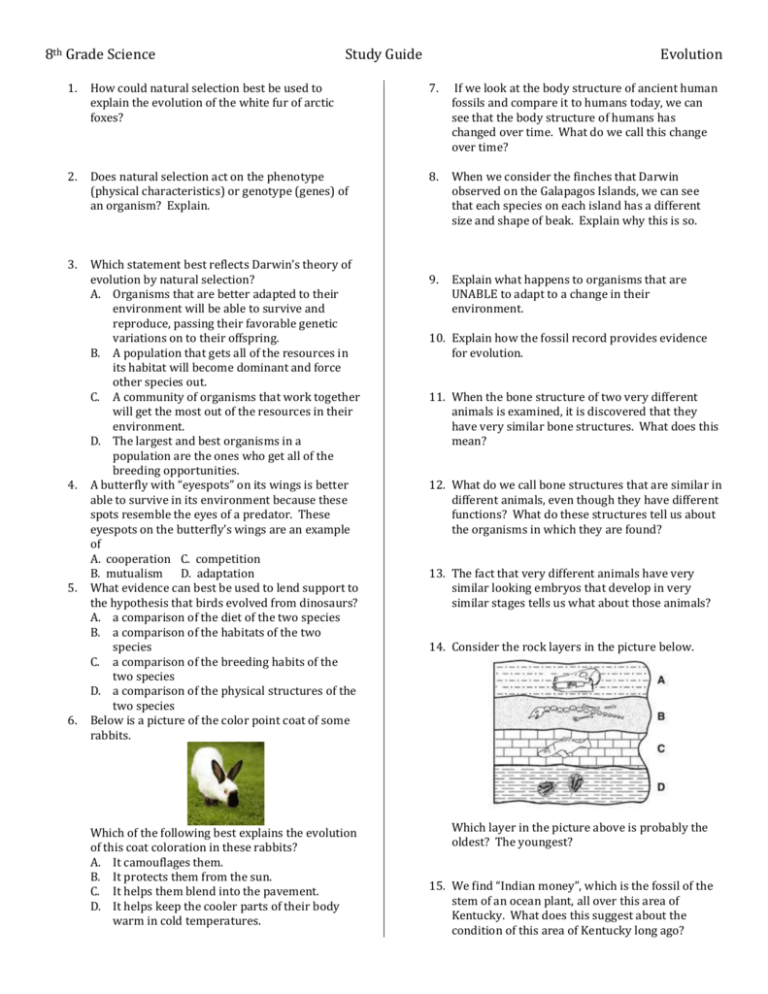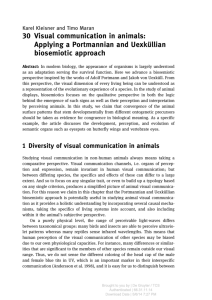Evolution Test Study Guide
advertisement

8th Grade Science Study Guide Evolution 1. How could natural selection best be used to explain the evolution of the white fur of arctic foxes? 7. If we look at the body structure of ancient human fossils and compare it to humans today, we can see that the body structure of humans has changed over time. What do we call this change over time? 2. Does natural selection act on the phenotype (physical characteristics) or genotype (genes) of an organism? Explain. 8. When we consider the finches that Darwin observed on the Galapagos Islands, we can see that each species on each island has a different size and shape of beak. Explain why this is so. 3. Which statement best reflects Darwin’s theory of evolution by natural selection? A. Organisms that are better adapted to their environment will be able to survive and reproduce, passing their favorable genetic variations on to their offspring. B. A population that gets all of the resources in its habitat will become dominant and force other species out. C. A community of organisms that work together will get the most out of the resources in their environment. D. The largest and best organisms in a population are the ones who get all of the breeding opportunities. A butterfly with “eyespots” on its wings is better able to survive in its environment because these spots resemble the eyes of a predator. These eyespots on the butterfly’s wings are an example of A. cooperation C. competition B. mutualism D. adaptation What evidence can best be used to lend support to the hypothesis that birds evolved from dinosaurs? A. a comparison of the diet of the two species B. a comparison of the habitats of the two species C. a comparison of the breeding habits of the two species D. a comparison of the physical structures of the two species Below is a picture of the color point coat of some rabbits. 9. Explain what happens to organisms that are UNABLE to adapt to a change in their environment. 4. 5. 6. Which of the following best explains the evolution of this coat coloration in these rabbits? A. It camouflages them. B. It protects them from the sun. C. It helps them blend into the pavement. D. It helps keep the cooler parts of their body warm in cold temperatures. 10. Explain how the fossil record provides evidence for evolution. 11. When the bone structure of two very different animals is examined, it is discovered that they have very similar bone structures. What does this mean? 12. What do we call bone structures that are similar in different animals, even though they have different functions? What do these structures tell us about the organisms in which they are found? 13. The fact that very different animals have very similar looking embryos that develop in very similar stages tells us what about those animals? 14. Consider the rock layers in the picture below. Which layer in the picture above is probably the oldest? The youngest? 15. We find “Indian money”, which is the fossil of the stem of an ocean plant, all over this area of Kentucky. What does this suggest about the condition of this area of Kentucky long ago? 8th Grade Science Study Guide 16. What is one major reason why scientists study fossils? Evolution 22. Use the graph below to determine the age of a fossil that has 12.5 grams of radioactive Strontium-90 left. 17. What type of rock are most fossils found in? A. Igneous C. Sedimentary B. Metamorphic D. Shale 18. What does the Law of Superposition tell us about the relative age of rock layers? 19. Consider the pictures of the rock layers below. 23. Consider the data table below Fossil Original Sr-90 Remaining (%) Dog bone 40 Piece of wood Clamshell Which rock layer in picture 2 is probably the same age as Layer G in Picture 1? Which rock layer in Picture 2 is probably the same age as Layer D in Picture 1? Explain how you know. 20. Consider the picture below. 20 Approximate Age (yrs) 30 60 10 This table shows the percentage of original Stronctium-90 remaining in three different fossils. The approximate ages of the dog bone and piece of wood are given in years. The age of the clamshell has been left blank. What is the approximate age of the clamshell fossil? 24. Consider the picture below. Which rock layer(s) indicate(s) a time when this area of land was under water? 21. What type of dating helps scientists determine a more accurate, numeric age of a fossil or rock layer? What is used to do this type of dating? What can we conclude about the rock layers in the picture above? A. There are no fossils in the bottom layer at location Y because fossils have not had the time to sink to that layer. B. The bottom layer at Location Z and the top layer at Location X are the same age. C. The bottom layer at Location X and the top layer at Location Z are the same age. D. The bottom layer at Location W is the oldest layer of all.





![F3-4 Study Guide for QUIZ [1/28/2016]](http://s3.studylib.net/store/data/006814899_1-56a576b1a51c0f876f28a8da0f15de89-300x300.png)




